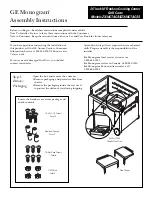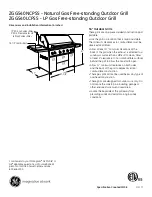
General Safety Rules
WARNING:
Read and understand all instructions. Failure to follow all instructions listed
below may result in electric shock, fire and/or serious personal injury.
SAVE THESE INSTRUCTIONS
Work Area
• Keep your work area clean and well lit. Cluttered benches and dark areas invite
accidents.
• Do not operate power tools in explosive atmospheres, such as in the presence of
flammable liquids, gases, or dust. Power tools create sparks which may ignite the dust or
fumes. Use in well ventilated areas only.
• Keep bystanders, children, and visitors away while operating a power tool.
Distractions can cause you to lose control.
Electrical Safety
• Double insulated tools are equipped with a polarized plug (one blade is wider than
the other.) This plug will fit in a polarized outlet only one way. If the plug does not fit
fully in the outlet, reverse the plug. If it still does not fit, contact a qualified electrician
to install a polarized outlet. Do not change the plug in any way. Double insulation
eliminates the need for the three wire grounded power cord and grounded power supply
system.
• Avoid body contact with grounded surfaces such as pipes, radiators, ranges and
refrigerators. There is an increased risk of electric shock if your body is grounded.
• Don’t expose power tools to rain or wet conditions. Water entering a power tool will
increase the risk of electric shock.
• Do not abuse the cord. Never use the cord to carry the tools or pull the plug from an
outlet. Keep cord away from heat, oil, sharp edges or moving parts. Replace
damaged cords immediately. Damaged cords increase the risk of electric shock.
• When operating a power tool outside, use an outdoor extension cord marked "W-A"
or "W." These cords are rated for outdoor use and reduce the risk of electric shock.
Personal Safety
• Stay alert, watch what you are doing and use common sense when operating a
power tool. Do not use tool while tired or under the influence of drugs, alcohol, or
medication. A moment of inattention while operating power tools may result in serious
personal injury.
• Dress properly. Do not wear loose clothing or jewelry. Contain long hair. Keep your
hair, clothing, and gloves away from moving parts. Loose clothing, jewelry, or long hair
can be caught in moving parts.
• Avoid accidental starting. Be sure switch is off before plugging in. Carrying tools with
your finger on the switch or plugging in tools that have the switch on invites accidents.
• Remove adjusting keys or wrenches before turning the tool on. A wrench or key that is
left attached to a rotating part of the tool may result in personal injury.
• Do not overreach. Keep proper footing and balance at all times. Proper footing and
balance enables better control of the tool in unexpected situations.
• Use safety equipment. Always wear eye protection. Dust mask, non-skid safety shoes,
hard hat, or hearing protection must be used for appropriate conditions.
Tool Use and Care
• Use clamps or other practical way to secure and support the workpiece to a stable
platform. Holding the work by hand or against your body is unstable and may lead to loss
of control.
• Do not force tool. Use the correct tool for your application. The correct tool will do the
job better and safer at the rate for which it is designed.
• Do not use tool if switch does not turn it on or off. Any tool that cannot be controlled
with the switch is dangerous and must be repaired.
• Disconnect the plug from the power source before making any adjustments,
changing accessories, or storing the tool. Such preventative safety measures reduce
the risk of starting the tool accidentally.
• Store idle tools out of reach of children and other untrained persons. Tools are
dangerous in the hands of untrained users.
• Maintain tools with care. Keep cutting tools sharp and clean. Properly maintained
tools, with sharp cutting edges are less likely to bind and are easier to control.
VEA EL ESPAÑOL EN LA CONTRAPORTADA.
SAVE THIS MANUAL FOR FUTURE REFERENCE.
INSTRUCTIVO DE OPERACIÓN, CENTROS DE SERVICIO Y
PÓLIZA DE GARANTÍA. ADVERTENCIA: LÉASE ESTE
INSTRUCTIVO ANTES DE USAR EL PRODUCTO.
INSTRUCTION MANUAL
Catalog Nos.
FSD122K, FSD142K,FSD182K
1
1
1
1
2
2
2
2
,,
,,
1
1
1
1
4
4
4
4
..
..
4
4
4
4
&
&
&
&
1
1
1
1
8
8
8
8
V
V
V
V
o
o
o
o
ll
ll
tt
tt
C
C
C
C
o
o
o
o
rr
rr
d
d
d
d
ll
ll
e
e
e
e
s
s
s
s
s
s
s
s
D
D
D
D
rr
rr
ii
ii
ll
ll
ll
ll
s
s
s
s
KEY INFORMATION YOU SHOULD KNOW:
• Battery pack must be charged for at least 3 hours before
initial use.
Cat #’s FSD122K, FSD142K, FSD182K Form # 605975-00
(AUG-01-2) Copyright © 2001 Black & Decker Printed in China
• Check for misalignment or binding of moving parts, breakage of parts, and any other
condition that may affect the tools operation. If damaged, have the tool serviced
before using. Many accidents are caused by poorly maintained tools.
• Use only accessories that are recommended by the manufacturer for your model.
Accessories that may be suitable for one tool, may become hazardous when used on
another tool.
Service
• Tool service must be performed only by qualified repair personnel. Service or
maintenance performed by unqualified personnel could result in a risk of injury.
• When servicing a tool, use only identical replacement parts. Follow instructions in the
Maintenance section of this manual. Use of unauthorized parts or failure to follow
Maintenance Instructions may create a risk of electric shock or injury.
Specific Safety Rules
• Hold tool by insulated gripping surfaces when performing an operation where the
cutting tool may contact hidden wiring or its own cord. Contact with a "live" wire will
make exposed metal parts of the tool "live" and shock the operator.
•
When working on a ladder or on scaffolding be sure to lay the tool down on its side
when not in use.
Some tools with large battery packs will stand upright but may be easily
knocked over.
WARNING: Some dust created by power sanding, sawing, grinding, drilling, and other
construction activities contains chemicals known to cause cancer, birth defects or other
reproductive harm. Some examples of these chemicals are:
• lead from lead-based paints,
• crystalline silica from bricks and cement and other masonry products, and
• arsenic and chromium from chemically-treated lumber. (CCA)
Your risk from these exposures varies, depending on how often you do this type of work. To
reduce your exposure to these chemicals: work in a well ventilated area, and work with
approved safety equipment, such as those dust masks that are specially designed to filter
out microscopic particles.
The label on your tool may include the following symbols.
V ..........................volts
A..........................amperes
Hz ........................hertz
W ........................watts
min ........................minutes
......................alternating current
......................direct current
no ........................no load speed
..........................Class II Construction
........................earthing terminal
........................safety alert symbol
.../min ..................revolutions or
reciprocations
per minute
Charging the Battery
THE BATTERIES IN YOUR POWER PACK ARE NOT FULLY CHARGED AT THE FAC-
TORY. BEFORE ATTEMPTING TO CHARGE THEM, THOROUGHLY READ ALL OF THE
SAFETY INSTRUCTIONS.
The charger is designed to use standard household 120 volt 60 Hz power.
1. Plug the charger into any standard 120 Volt 60 Hz electrical outlet.
2. Slide the charger onto the battery pack as shown in Figure 1 and let it charge for at least
3 hours.
3. Remove pack from the charger and place in tool. NOTE: To remove the battery from the
drill, press down on the release button on the back of the battery (Figure 2) and slide out.
Important Charging Notes
1. After normal usage, your power pack should be fully charged in 3 hours or less. If the
power pack is run-down completely, it may take up to 6 hours to become fully charged.
Your power pack was sent from the factory in an uncharged condition. Before attempt-
ing to use it, it must be charged for at least 3 hours.
2. DO NOT charge the batteries in an air temperature below +40°F or above +105°F. This
is important and will prevent serious damage to the batteries.
3. While charging, the charger may hum and become warm to touch. This is a normal con-
dition and does not indicate a problem.
4. If the batteries do not charge properly –
(1) Check current at receptacle by plugging in a lamp or other appliance.
(2) Check to see if the receptacle is connected to a light switch which turns power off
3
4
1
2
Trigger Switch
Interrupteur à détente
Gatillo interruptor
Depress for reverse (this side)
Enfoncer pour la marche arrière
Oprima para marcha hacia adelante
Depress for forward (other side)
Enfoncer pour la marche avant
Oprima para reversa
Screw Icon
Symbole d’une vis
Icono de tornillo
Drill Bit Icon
Symbole d’une mèche de perceuse
Icono de broca
Torque Adjust Collar
collier de réglage du couple
collarÍn de ajuste de par (torque)
Gear Shifter
Sélecteur de vitesses
Palanca de cambio de engranes
5
7
8
6
Level
Niveau
Nivel
BEFORE RETURNING THIS PRODUCT
FOR ANY REASON PLEASE CALL
1-800-54-HOW-TO (544-6986)
IF YOU SHOULD EXPERIENCE A PROBLEM
WITH YOUR BLACK & DECKER PRODUCT,
CALL 1-800-54-HOW-TO (544-6986)
BEFORE YOU CALL, HAVE THE FOLLOWING INFORMATION AVAILABLE, CATALOG No., TYPE No., AND
DATE CODE (e.g. 20000130M). IN MOST CASES, A
BLACK & DECKER
REPRESENTATIVE CAN
RESOLVE YOUR PROBLEM OVER THE PHONE. IF YOU HAVE A SUGGESTION OR COMMENT, GIVE
US A CALL. YOUR FEEDBACK IS VITAL TO BLACK & DECKER.























